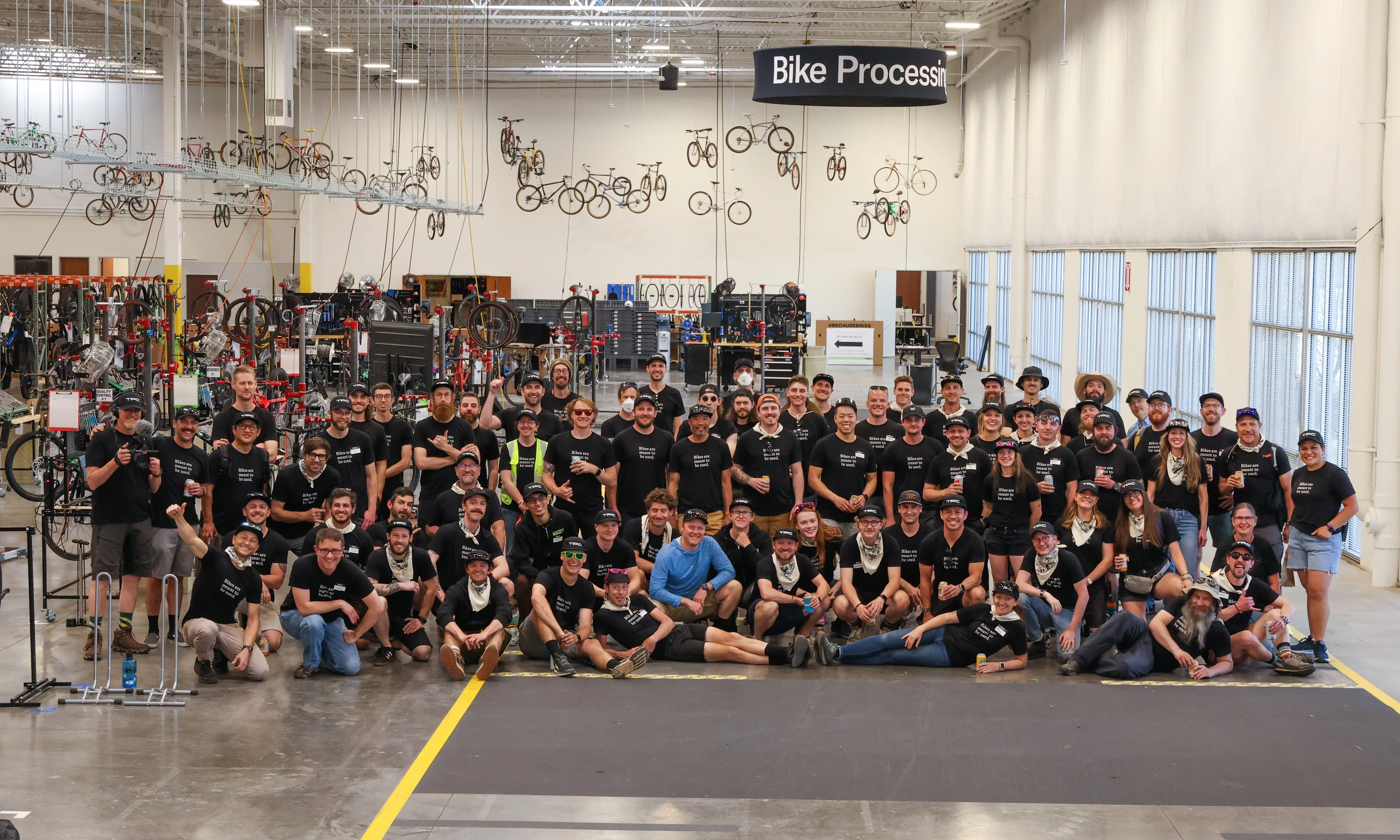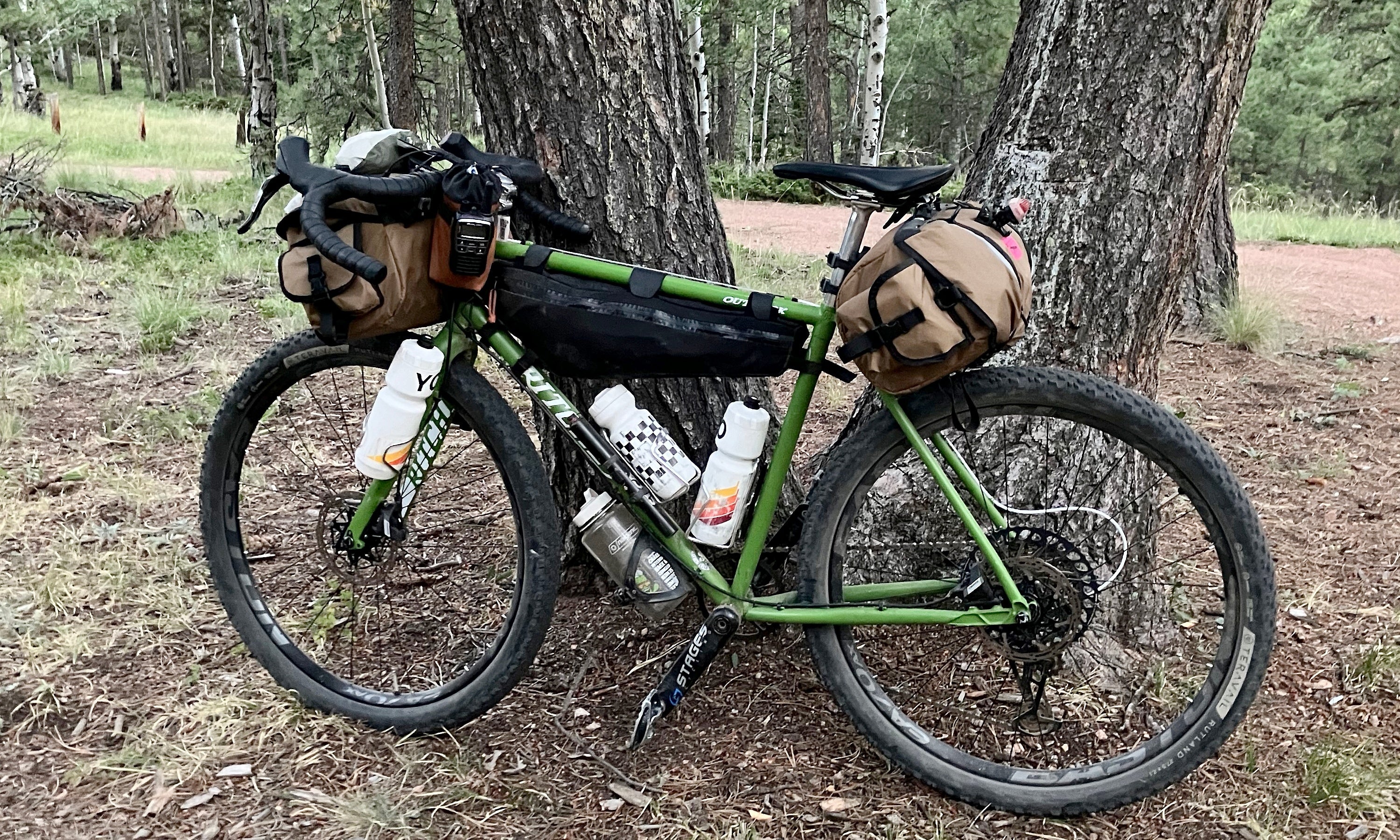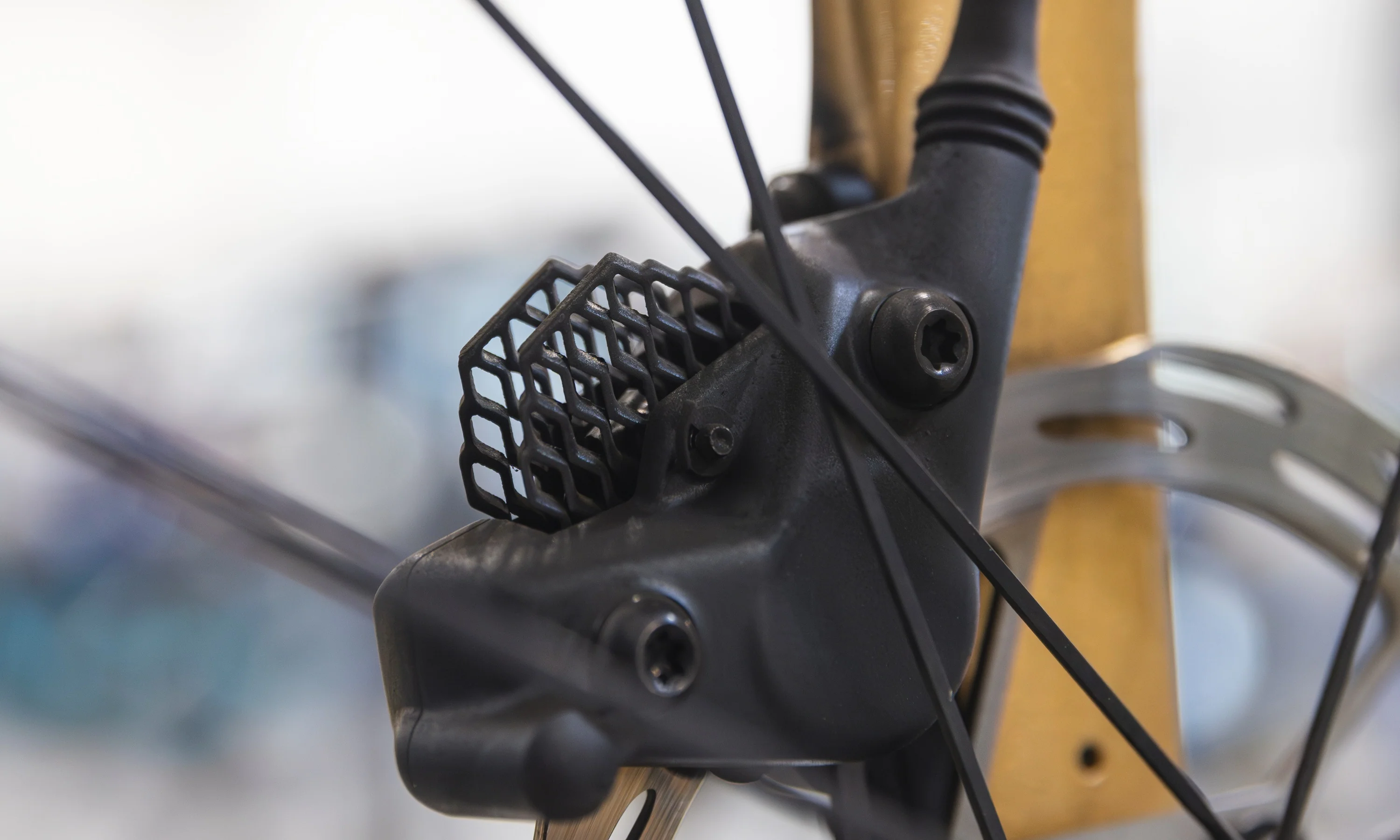Illustration by Ping Zhu (who rides a Crust Romanceur)
They weren’t wearing cycling kits. They had eye-catching wine-colored Stan Ray jackets, American-made and custom-embroidered. They weren’t riding carbon fiber race bikes. Each had a bespoke steel steed, meticulously assembled with the right parts. And they didn’t look like most of the people who turned out for Mid South gravel in Stillwater, Oklahoma. They were a diverse mix of people of color.
This is the team that Crust Bikes brought to one of the biggest gravel races in the country last month. And it’s probably wrong to call it a “team,” because it goes way beyond that. They embodied all of the things that make Crust special.
The seven riders in cotton twill chore jackets reflected the elements that have made Crust one of the most interesting and influential bike brands today. Crust’s ethos welcomes riders from unconventional backgrounds and draws on elements of surf, skate, and fashion culture. It keeps things fun when so often the bike industry wants you to wear a game face.
As Crust’s influence continues to grow, it will have a profoundly positive influence on cycling, from fresh faces at events to its laid-back, vintage-inspired steel frames. In fact, this change has already begun.
[button]Shop gravel bikes[/button]
Born out of necessity
On a bike tour in Nepal, Matt Whitehead got desperate. The Surly he was riding just wasn’t working for him. Long days and heavy luggage were taking a toll on both bike and rider.
One evening, in a Nepalese hostel, he decided to find a better bike. No, he decided to make a better bike. He pulled up his iPod touch (it was 2014) and started emailing factories in Taiwan. These weren’t companies he’d worked with before. He didn’t have any contacts. A plumber by trade, Whitehead wasn’t in the bike industry. These were honest-to-goodness cold calls.
“Matt’s very scrappy. Any situation he finds himself in he’ll find a solution,” said his wife Angelica “Cheech” Casaverde a few weeks after Mid South.

Matt Whitehead and the original Crust Evasion. Photo: John Watson | The Radavist
About six months after that tour through Nepal, Whitehead had his first sample of what became the Crust Evasion, a mainstay of the brand’s frame lineup built for touring, gravel, and all manner of far-flung adventures.
The more you learn about Whitehead, the more it seems understandable — maybe inevitable — that he would launch a bike brand with little to no experience. After all, his first bike tour came about unexpectedly, in 2009, when he was robbed of most of his money in Mexico City. Without a better option, he bought a bike with what little he had left and rode to his nearest friend’s house. In Austin, Texas.
An unplanned, three-week, 15,000km ride would have killed most people. Instead, it sparked his love for long-distance touring.
[newsletter]
Gravel bikes with BMX vibes
The name is Australian slang for making a living (Whitehead is Australian), as in “What do you do for a crust, mate?” Whitehead never expected to be doing Crust for a crust. Yet he intuitively knew how to promote his fledgling brand, especially on Instagram, and Crust caught on pretty quickly.
“I think a lot of people didn't take Matt seriously at first because when you meet Matt, he's just like this wildcard,” said Cheech. “He's like this wild Australian that's throwing around the c-word [not “Crust”] every 10 seconds and like out of his mind, but he's really smart.”
Once he found Whitehead on Instagram, Benedict “Ultra Romance” Wheeler was drawn to his unconventional fat-tired drop-handlebar bikes and his wild adventures, like strapping a surfboard to the side of his prototype Crust to combine surfing and bike touring.
“In designing and creating the first Evasion, I thought maybe I’d sell one round if I was lucky. If I thought the Evasion was cool, there might be just enough people who thought the same.” — Matt Whitehead
“Bikes aren't made by just some scraggly Australian guy. This guy looks like he just rolled out of a dumpster, you know?” Wheeler said laughing. “And so I didn't know really what to think. He had great ideas, and what did I have to lose? We hit it off. ”
When they finally connected in person, they dreamed up Wheeler’s signature bike, the Romanceur. Like the BMX brands that Whitehead grew up with, he wanted Crust to have interesting, influential riders who designed and rode their own signature frames.
“He said he wanted to run Crust like a BMX company,” said Wheeler. “And he wanted me to do one of the frames. I was like, that's a really cool way to do it. Immediately he had some great ideas for non-standard ways of running a bike company.”
 Charismatic cult leader or gravel trendsetter? Whatever he is, Benedict Wheeler tries not to take it too seriously. Photo: John Watson | The Radavist
Charismatic cult leader or gravel trendsetter? Whatever he is, Benedict Wheeler tries not to take it too seriously. Photo: John Watson | The Radavist
The only catch is that when you’re building a bike to suit someone like Wheeler and his eccentric preferences, it’s less of a sure thing, commercially speaking. Neither of them had high expectations that the world was ready for Crust bikes.
“No one in this world is unique and no idea is unique, no matter what people think,” Whitehead said. “In designing and creating the first Evasion, I thought maybe I’d sell one round if I was lucky. If I thought the Evasion was cool, there might be just enough people who thought the same.”
The good news was — whether they were marketable or not — the bikes were damn fun to ride.
“I remember building that thing up, taking it out for a ride and just sprinting it down the road, bursting into a trail like a little New England rooty trail, down some granite rock face, a little bit of singletrack, hopped over a log, and then back onto the road. And the thing just soared the entire way,” said Wheeler of his first Romanceur. “I had never ridden a drop-bar bike with tires that were like these balloons for tires, you know? And I'm just like, this is f—king awesome.”

The legendary Crust Romanceur. This one's extra special because it belongs to Wheeler's partner, Arya, who rode it in the 2021 Tour Divide. See more photos on The Radavist. Photo: John Watson | The Radavist
Crust catches on
Crust began small, with a sample size run of 10 Evasion frames in 2015. In late 2016, a full run of 100 Romanceurs came in. Whitehead anticipated that Ultra Romance’s influence on Instagram and social media would help sell bikes. He was right.
Perhaps he underestimated his own influence as well. The fact that he thought the Evasion was cool helped sell it. He shared it with the world, traveling around, meeting people, and cultivating a following on social media. Crust was an extension of his persona.
“People saw how Matt was living his life and were attracted to it,” Cheech said. “The flamboyant colors, palm trees, play on words, grimy BMX background. It’s so different to big bikes where everything seems so polished.”
He also didn’t censor his ideas, no matter how raunchy they were. At one point, Crust sold a stem called the Limp Dick (now toned down to be simply the LD). Whitehead made sure to wrap each stem in a condom before shipping. Sometimes, he even had Cheech kiss them with lipstick. As you’d imagine, that was a pretty effective way to get people posting about Crust online.
Maybe that comes off as a crass stunt, but Whitehead donated the profits from those stems to Charlie Cunningham, who originally created that stem design. Cunningham, a legendary bike designer and Mountain Bike Hall of Famer, is disabled due to a bike crash in 2015.
“It was artists, skateboarders, aging BMXers who were ready to have a bike with bigger wheels. It's not your typical cyclist in the beginning for sure.” — Benedict "Ultra Romance" Wheeler
Beyond the image, Crust bikes themselves made a lot of sense at a time when gravel cycling’s popularity was exploding, yet most of the technology was driven by racing and cycling tradition.
“It almost creates its own style, right? Like the fat-tire, drop-bar thing, which is so commonplace now, wasn't then,” said Wheeler. And though he admits some people retrofit vintage mountain bikes to get a similar set-up, the modern details and geometry of a new Crust frame appeal to a lot of people. “I think Crust, as a brand, nearly invented that type of bike in the mainstream world.”

Crust's Evasion frameset takes many forms. This bike, featured on The Radavist, is the flat-bar configuration. Photo: John Watson | The Radavist
With good aesthetics, versatile designs, and a quirky vibe, Crust did not appeal to typical cyclists at first. It attracted a fresh type of rider — compounded by the coolness that already surrounded Crust.
“It was artists, skateboarders, aging BMXers who were ready to have a bike with bigger wheels. It's not your typical cyclist in the beginning for sure,” said Wheeler of Crust’s early adopters.
A B-side version of cycling
Crust makes bikes that represent real people with interesting, unconventional stories. That’s one key way it connects with new customers from different backgrounds. It inspires and encourages people to approach cycling in a way that colors outside the rigid lines usually drawn by white men who like racing.
Take Louie Lopez, one of the world’s top pro skateboarders, and also a first-generation American whose mother is Mexican and father is Guatemalan. He was at Mid South Gravel. He was riding an amazing pink Crust Bombora.
“I think that they are creating an entirely new sub-genre, you know, like a B-side version of a cyclist. People are like, ‘I feel welcome here now when I never did before.’" — Bobby Wintle
The bikes themselves reflect that mix of people from different backgrounds. The colors and graphics are playful. The frames are steel with welcoming curves inspired by vintage randonneuring bikes. Prices aren’t dirt cheap, but most framesets are under $1,500, approachable for a lot of cyclists.
Above all, Crust bikes don’t make you feel like you have to measure up to a stereotype that’s born out of racing, a ubiquitous influence on most bike designs. Crust bikes reflect the wanderlust spirit that brought about the first Evasion.
“I think that they are creating an entirely new sub-genre, you know, like a B-side version of a cyclist,” said Bobby Wintle, Mid South race director and owner of District Bicycles, an award-winning bike shop in Stillwater. “People are like, ‘I feel welcome here now when I never did before.’ And all of a sudden, now they're paying attention when maybe bikes wouldn't have got their attention if it weren't for people like Matt and Cheech.”

The Crust team at Mid South Gravel. Cheech is the horizontal one. Photo: John Watson | The Radavist
Fielding a diverse team of interesting people is another key way that Crust opens the door to cycling. Cheech, as an Indigenous Latina, is a big part of that.
“For the cycling industry to have more culture, there need to be people from different walks of life doing things genuinely. Because you're not going to get the same result that I'm giving you from a boardroom full of white people that are forcing it,” she said.
Cheech was modest about Crust’s broader appeal to people who the bike industry usually ignores, as well as her role in assembling the team for Mid South. These riders are just her friends, and because she’s a woman of color, those people feel welcome to participate.
“For me to take my friends to Oklahoma — it’s an incredible experience, but nothing was forced about it,” she said
In his typical enthusiastic fashion, Wintle said the Crust team’s impact on his event went way beyond that.
“Mid South has always been a positive environment, but not like this. This year was something very special,” he said. “My dad was there, and he’s like, ‘I want to hang out wherever they're hanging out.’ They 100% elevated what we were already trying to do at Mid South, without us even talking about it ahead of time. They gave us exposure that we could have never have done on our own.”
[product-block handle="crust-bombora-xxl"/]
The Crust effect
Crust is far from the only company to help revitalize interest in steel bikes, touring, randonneuring, and a generally more relaxed approach to riding. All-City, Surly, and countless handbuilt brands deserve a lot of credit, too.
It just feels a bit different with Crust. Perhaps some of it is related to the style, informed by Cheech’s expert eye for fashion and design. When she met Whitehead, she was “running away from a boring desk job in corporate fashion” in New York City. They’re now selling a complete line of clothes alongside Crust bikes, called Casa Verde.

Cheech has been part of Crust from the start, although she came from a background in fashion design, not cycling. Photo: Matt Whitehead
“I don't think Matt and I and Cheech are anti-bike industry, it's just separate from that. It's not the same thing,” said Wheeler. “It's just cool to have something that surprises you, like, oh, that's a bike company too. That’s a totally different thing.”
Casa Verde is exactly as cool, casual, and stylish as you’d expect, based on Cheech’s background and the overall Crust vibe. It’s just one more way that Crust presents itself as a welcoming alternative to performance-centric lycra and carbon fiber. And appearances count for a lot.
“I see it trickling down into big brands. Not only in the bikes, but in apparel too,” said Wintle. “Aesthetically, they're like, ‘Hey, are you into this? Does this look good? Is this a little bit, maybe, alternative? Then, maybe we should try it out.’ I'm seeing that all across the industry. And why did it take the bike industry so long to return to this?”
The “this,” is fun, practical, comfortable, durable bikes (and clothes) that bring more people into the fold. The “why” is a more shifty question.
“For the cycling industry to have more culture, there need to be people from different walks of life doing things genuinely." — Angelica “Cheech” Casaverde
Overall, the bike industry tends to be very risk-averse. Focusing on products that support established racing formats, made for existing, committed cyclists — it is the conservative choice. The accountants like it.
“While all these big brands are having meetings, bouncing around, like, ‘Is this gonna sell? Is this gonna sell?’ Matt is just doing it, which kind of puts him at the forefront of what's happening a little bit,” said Cheech. “And then I think bigger brands kind of take notice and, you know, follow along. I think that's been at least my experience, with the Evasion.”
By now you may have realized that Whitehead, Cheech, and their company Crust did not set out to avoid risks. They didn’t plan to follow the bike industry’s lead. They willingly and frequently say that they didn’t care if Crust succeeded or if people bought the Bombora, Florida Man, or Evasion. They built what they wanted, what their friends wanted.
That turned out to be just what the bike world needed.













